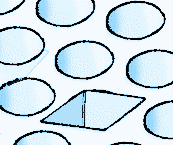After what and why, the third question is usually something along the lines of "Is it normal", "Is it safe", or more generally,
By B. Terrance Grey

Understanding the safety and acceptability of the desires of Adult Babies and/or Diaper Lovers (ABDLs) might be both important and beneficial. Those with such desires will generally need to live with them. The causes of these desires might be interesting as personal history, but safety and acceptability matter in the present.
Having these desires and identifying as an ABDL does include specific risks. However, most of these risks are external, the result of a cultural bias that generally presumes that being 'abnormal' is bad. Like the square peg, ABDL individuals often don't fit in.
Following the COVID-19 pandemic, a majority of ABDL individuals reported that ABDL practices improved mental health, but they also reported a mild depression-anxiety comorbidity on average(Sevier, 2023)[1].
From a medical perspective, ABDL practices are relatively safe. There is an increased exposure to diaper rash, but this is manageable. Diapers may protect against some STIs if the bodily fluids are absorbed into the diaper instead of exchanged between partners.
The medical diagnosis for enjoying diapers and/or acting as a baby is fetishism and/or infantilism. Starting in 1987, infantilism was defined as a type of masochism(APA 2000)[2]. It was removed in 2013(APA 2013)[3], possibly because it lacked popularity (in contrast to general masochism) and significant medical risks (in contrast to inherently dangerous sexual practices such as autoerotic asphyxia). While rare, fetishism and/or infantilism are fairly safe. ABDL practices are generally not problematic(Hawkinson & Zamboni 2014)[4].
Infantilism or diaper fetishism each have a single symptom: A manageable desire to wear diapers and/or act like a baby. Individuals with more severe symptoms might have some other condition(Grey 2014)[5].
For example, depression due to cultural stigmas and marginalization are fairly common within the ABDL community. A diagnosis of clinical depression was reported by 21% of ABDL survey participants(Grey 2009)[6]. This is especially true for older individuals who, before the Internet, might have thought that there were no others with similar desires.
ABDL individuals might also suffer binge-purge cycles as a result of trying to quit their desires. These cycles might be emotionally damaging. Binge-purge cycles were reported by 56% of ABDL survey participants, including 15% who were going through them at the time of the survey(Grey 2008)[7]. The cycle might be broken through self-acceptance or moderation.
While roughly 10% of ABDL individuals reported some form of long-term incontinence, only around 1% reported that this was a result of their ABDL interests(Grey 2014)[5]. This might have followed extended efforts intended to develop incontinence. In contrast, 4% adopted ABDL interests as a result of incontinence, perhaps as a means of enjoying necessary diapers.
Multiple independent studies suggest that ABDL individuals generally do not have a sexual interest in children (Fuss et al. 2019)[8], (Hsu & Bailey 2023)[9]. The data are consistent with the statistical independence that completely separate conditions would have. Infantilism and peophilia might only be associated in that both involve the aspect of age. However, one involves wanting to be a baby sometimes, while the other involves wanting to be with children sexually.
For discussion, let's consider parents who have found out that their son is collecting diaper ads from magazines, and that their son has two posters on his bedroom wall. One poster is of a race car driver with a mustache, leaning on his car. The other poster is of a supermodel in a bikini, also leaning on a car. The son probably wants to be like the driver (i.e. rich and famous). The driver is a typical role model. In contrast, the son probably wants to be with the supermodel (i.e. romantically or sexually).
This be-like versus be-with contrast is common in media, but not often discussed. When asked about their favorite media item, 51% of ABDL participants reported an item that centered on a character they want to be like(Grey 2014)[10]. This can be confusing on two points.
First, those who aren't familiar with ABDL media might presume it to have the consistency of heterosexual pornography: With heterosexual pornography, any particular picture is probably a picture of one or more be-with women models, marketed to men. A be-like male might also be present, but perhaps only as a penis. This consistency is one reason the be-like versus be-with contrast is not discussed often. Granted, some ABDL pornography is like heterosexual pornography. For example, it might be a picture of a woman model in a diaper instead of a bikini. However, heterosexual ABDL men might be more likely to favor a picture of a man in diapers, whom they wanted to be like. In turn, that picture of the woman in the diaper might be enjoyed by an ABDL transwoman, who wanted to be like her. The only strongly valid generalization is that assumptions might be wrong. The parents might assume that the boy viewed the diaper ads as be-with media. They might assume this because it doesn't include a typical role model, it was hidden in the places where boys might typically hide pornography, people tend to fear the worst instead of the most likely, etc. That boy might simply wish to be in diapers, like the babies in those ads.
Second, that boy's collection might be limited by availability. His true preferences might only be reflected later, as an adult with unrestricted Internet access. He might not desire to be a baby, but to be rich, famous, and in a diaper. He might only be collecting diaper ads because he doesn't have access to pictures of diapered racecar drivers.
There are many potential points of misunderstanding. However, these can be resolved by communication with open minds. Infantilism and pedophilia are often likened merely because both involve age in some way. This is no more scientific than confusing the driver with the supermodel since both are leaning on cars in the posters.
ABDL practices generally take place between consenting adults.
As adults, ABDLs might start families of their own. They would then face decisions about what to tell the children and when, and would need to take measures against the children discovering more. These might be similar to the difficulties that parents face about heterosexuality, except for the comradery from knowing that such difficulty is faced by every parent.
Stormbird offers a perspective on being an ABDL parent as well as a note to parents of ABDLs.
The ABDL population might be fairly average in their wealth and income, after compensating for their age, ethnicity, nationality, etc. ABDL appearances, such as on TV, are often of individuals without careers, because most with careers would prefer not to be fully open about their ABDL desires. Some studies (e.g.Hawkinson & Zamboni 2014[4]) report a mode income that seems low compared to the average age. The average age includes mid- and late-career-aged ABDLs, and no participants under 18. The mode participant is typically college-student-aged, and so might not have much income currently. The result is a early-career average age, a college student mode income, and an example of the danger of comparing averages with modes.
Diaper usage does have an ecological impact, with a measure of resources consumed, carbon expelled, and landfill space used. Due to cultural biases, these might be judged more harshly than other ecological impacts. Eating meat, gas-powered cars, large families, and many other practices also have an ecological impact. At the risk of being prescriptive, all humans should be mindful of their total individual ecological impact.
Most ABDL individuals were raised in predominately Christian regionsGrey 2013[11]. ABDL practices are not directly addressed in the Bible, although there are some verses might have some relevance. Christian morality is not black-and-white on this issue. Here especially, a compliance to a perceived norm might be tacitly required, along with the presumption that everyone can choose to comply with that norm. ABDL survey participants reported a decline in their being religious, from 42% as teens to 23% at the time of the survey(Grey 2008)[12], although this might be due to cultural shifts as well as personal changes.
ABDL individuals might face a degree of social isolation. They will need to be careful whom they come out to. Being more open reduces the negative perception of 'having something to hide', but may be indiscrete, exposing others to more than they wanted to know. Others might use or spread the information in malicous or hurtful ways. Comming out is also irreversible.
Children might have limited access to information on ABDL and other adult topics, perhaps only through their parents. They might think that they are the only ones with these desires. A lack of privacy and the risk of discovery also might factor in to the decision to tell parents and/or siblings, or not. Only 13% of ABDL individuals reported discussing their interests with parents, excluding the 19% who were discovered(Grey 2013)[13]. Discussing ABDL interests with parents might be awkward for a number of reasons. Notably, the child and the parent will have different contexts for the conversation: The parent might remember the child's many past diaper changes quite differently than the child, who might not remember them at all(Grey 2013)[14].
This isolation might ease with adulthood, and with it, access to ABDL communities. Prior to this, ABDL individuals might not have been able to interact with others who shared similar beliefs.
ABDL survey participants often told their partner early in the romantic relationship and advised others to do so (Zamboni 2018)[15]. Delaying too long, or being discovered accidentally, might be hurtful and might be perceived as dishonest.
 There are many drawbacks to growing up with ABDL desires. These may include isolation and limited information when young, followed by struggles to comply with potentially-unrealistic cultural norms. These may have lasting negative effects. However, these are generally rooted in how a culture handles diversity or the ABDL individual's expectations of such. They are not an integral component of ABDL desires and practices.
There are many drawbacks to growing up with ABDL desires. These may include isolation and limited information when young, followed by struggles to comply with potentially-unrealistic cultural norms. These may have lasting negative effects. However, these are generally rooted in how a culture handles diversity or the ABDL individual's expectations of such. They are not an integral component of ABDL desires and practices.
As adults, those with ABDL desires might have better access to information and to ABDL communities. They will know that they are not alone. They generally will still have rare desires, but they might better resist the tendency to internalize culture's condemnation of the abnormal. They might be able to reject or replace unrealistic expectations, learn to accept themselves, and build from there. They might be able to find - or make - a place where they can fit in.
Revised 15 June 2024: Expanded to include more topics and recent sources. Most sections are new.
Do you have Questions, tips, suggestions, or other feedback?
|